
Product ID: SQMIG15E2450

Report ID:
SQMIG15E2450 |
Region:
Global |
Published Date: February, 2024
Pages:
157
|
Tables:
62 |
Figures:
75
Global Friction Modifiers Market size was valued at USD 963.03 Million in 2021 and is poised to grow from USD 996.74 Million in 2022 to USD 1312.51 Million by 2030, at a CAGR of 3.5% during the forecast period (2023-2030).
The global friction modifiers market has witnessed substantial growth in recent years, driven by the increasing demand from various industries such as automotive, aerospace, and manufacturing. Friction modifiers are chemical additives used to reduce friction and wear between two interacting surfaces. They are employed in lubricants, oils, and greases to enhance the performance and efficiency of machinery and equipment. One of the key growth factors for the global friction modifiers market is the rapid expansion of the automotive industry. As automotive manufacturers strive to meet stringent emission regulations and improve fuel efficiency, the demand for friction modifiers has soared. These additives help in reducing energy losses due to friction and improve the overall performance of automotive components, including engines, transmissions, and drivetrains. Moreover, the rising adoption of high-performance lubricants and the growing awareness regarding the benefits of friction reduction are bolstering market growth. Industries such as aerospace, marine, and industrial machinery rely heavily on lubricants and oils to ensure smooth operations and prevent mechanical failures.
Friction modifiers play a crucial role in minimizing wear and tear, thereby extending the lifespan of critical components and reducing maintenance costs. However, the global friction modifiers market also faces several challenges. One of the primary obstacles is the fluctuating prices of raw materials. Many friction modifiers are derived from petroleum-based chemicals, and the volatility in oil prices directly impacts the manufacturing costs. Additionally, stringent environmental regulations and increasing concerns about the environmental impact of chemical additives pose challenges to the market. Companies are under pressure to develop sustainable and eco-friendly friction modifiers to comply with regulations and meet consumer demands. Furthermore, the market is highly competitive, with numerous players offering a wide range of friction modifiers. This intensifies the competition among manufacturers, leading to pricing pressures and the need for constant innovation. Companies are investing in research and development activities to develop advanced friction modifiers with improved performance characteristics.
Our industry expert will work with you to provide you with customized data in a short amount of time.
REQUEST FREE CUSTOMIZATIONWant to customize this report? This report can be personalized according to your needs. Our analysts and industry experts will work directly with you to understand your requirements and provide you with customized data in a short amount of time. We offer $1000 worth of FREE customization at the time of purchase.

Product ID: SQMIG15E2450